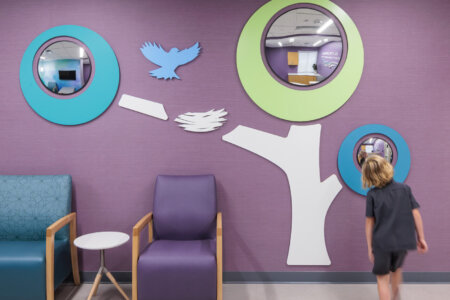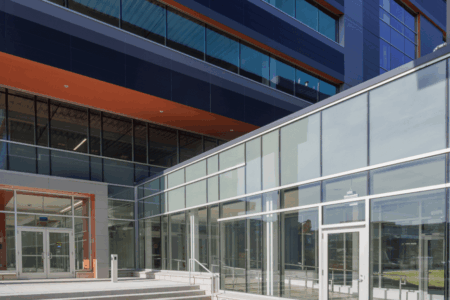Healthcare Design Trends for 2025 and Beyond: AI, Pediatrics, and the Continuum of Care

RSP Principal and Healthcare + Life Sciences Lead Amy L. Williams notes some of the biggest healthcare design trends that will impact health organizations for years to come.
The healthcare industry is undergoing a major transformation. New technologies, shifting patient needs, and an increased focus on holistic well-being are redefining how care is delivered, and how healthcare spaces are designed. The challenge isn’t just keeping up; it’s anticipating what comes next. How will hospitals accommodate robotic systems? What role does design play in behavioral health? How do we create flexible environments that adapt to evolving models of care?
These are the questions shaping the future of healthcare. Three key trends stand out: the rise of robotics and AI, a growing emphasis on pediatric and behavioral health, and a push toward a seamless continuum of care. From automated pharmacies to trauma-informed interiors and patient rooms that adapt in real time, these innovations are changing the way we think about healthcare spaces. Let’s explore how each of these trends is influencing design—and why they matter.
1. Robotics and AI: The Next Frontier in Healthcare Design
AI and robotics are no longer futuristic concepts in healthcare—they’re here, and they’re making an impact. Hospitals are integrating AI-driven diagnostic tools, robotic-assisted surgeries, and automated medication management to improve patient care and streamline operations. The results are promising: a recent study found that AI-generated post-operative reports contained fewer inconsistencies than those written by human surgeons, with 29% of AI reports showing discrepancies compared to 53% of surgeons’ reports. Of course, new regulations will likely be necessary to make sure that a human reviews these notes, but in this case, the use of AI could save time and save lives.
And this type of technology isn’t limited to the operating room. The healthcare AI market is exploding, projected to grow from $26.69 billion in 2024 to $613.81 billion by 2034, with a compound annual growth rate of 36.83%. But integrating this technology isn’t just about efficiency—it’s also about rethinking space. Robotics require dedicated pathways, automated storage systems, and adaptable infrastructure. Designers must anticipate these needs, ensuring that healthcare spaces are not just functional today but ready for what’s next.
2. The Rise of Pediatric and Behavioral Health-Focused Design
Mental health and pediatric care are getting long-overdue attention in healthcare design. Trauma-informed environments, biophilic design, and sensory-friendly spaces are becoming essential in hospitals, clinics, and behavioral health facilities. Research shows that incorporating nature into healthcare settings—such as access to natural light and indoor greenery—can reduce stress and promote healing.
For children, the environment plays an even more crucial role. Spaces designed for pediatric and behavioral health patients now feature flexible lighting, interactive elements, and colors carefully chosen to promote calmness and engagement. Sensory rooms, equipped with adjustable lighting and sound controls, allow patients to manage their environment, creating a more supportive and personalized experience.
These considerations go beyond aesthetics—they impact patient outcomes. A well-designed behavioral health facility can reduce stress, enhance communication between providers and patients, and improve overall well-being. As awareness of these needs grows, so does the demand for spaces that prioritize mental health and pediatric care.
3. The Continuum of Care: A New Model for Healthcare Delivery
The days of rigid, one-size-fits-all healthcare facilities are fading. Patients now expect care that transitions seamlessly from hospitals to outpatient clinics to home-based treatment. This shift, known as the continuum of care, is driving the need for more flexible, connected environments.
Telehealth and remote monitoring have made healthcare more accessible, reducing the need for long hospital stays. As a result, facilities must be designed with adaptability in mind. Smart patient rooms—where lighting dims when a doctor enters, or technology seamlessly integrates virtual consultations—are becoming the norm. These innovations ensure that healthcare is more personal, efficient, and responsive to patient needs.
A well-designed continuum of care doesn’t just benefit patients—it also improves efficiency and reduces costs. By creating spaces that support both in-person and remote care, hospitals can better allocate resources and improve patient outcomes.
The Future of Healthcare Design Trends
As healthcare evolves, so must the environments where it takes place. Robotics and AI are streamlining operations and redefining space planning. Pediatric and behavioral health-focused design is improving patient experiences and outcomes. The continuum of care is breaking down barriers between different types of treatment, requiring flexible, tech-enabled spaces.
For designers, the challenge is clear: create adaptable, forward-thinking environments that meet the needs of today while anticipating the demands of tomorrow. By embracing these trends, healthcare spaces can become more efficient, patient-centered, and ready for the future.
Featured Image:
Project: Family Consult Room, M Health Fairview Blythe Brenden Children’s Clinical Research Center | Photography: Brandon Stengel farmkidstudios.com




